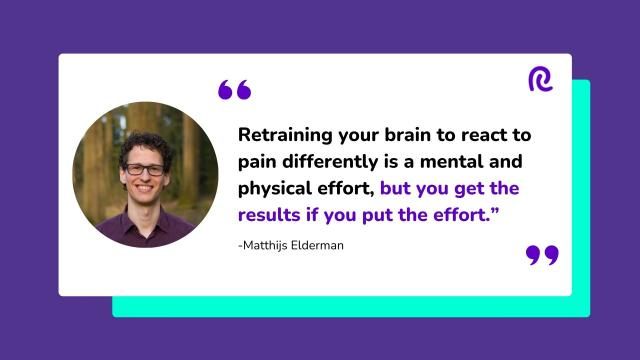Background
Lisanne Tilma is a physiotherapist at Spectrum Leeuwarden who specialises in treating the behavioural and emotional issues that can cause or exacerbate pain. For years, she worked with patients who suffered from chronic pain. She treated many patients daily and was used to getting wildly different reactions to her interventions. She helped some people, but others didn't remember what she had taught them the previous week. It was very repetitive, constantly telling the same story. Sometimes it went well, and her way of explaining chronic pain would "fit" with a particular patient, and they would make progress. At other times she realised she would over-explain, overloading her patients, so they didn't make as much progress. Lisanne knew there must be a better way of helping patients learn about their pain and what they could do about it. She knew there must be some way for people to see, hear and experience the content rather than just being exposed to it.
One day, Louis (one of Reducept's founders) presented Reducept at Spectrum Leeuwarden, which captivated Lisanne. It seemed to tick the boxes: Reducept had won some prizes for Innovation. Many patients had transformative stories about their lives before and after learning about pain and pain management techniques through the Reducept VR game. Lisanne started to use Reducept in her practice. She noticed that she had used all the methods built into the VR game, but with Reducept, the patient was free to try a few different ways of working and stick with the ones that 'clicked' with them. Lisanne could sit back and see which techniques the patient preferred before tailoring her physiotherapy exercises to the patient's preferences. Patients were happier than before, results were more consistent than when she did it all herself, and patients remembered what they had learned! Could Reducept be a valuable tool to help her treat patients more consistently?
Using Reducept at work
No matter how well it worked for patients, it needed to fit into her daily work as a physiotherapist. A typical physiotherapy session is 30 minutes. That is far too little time to play through all the exercises in the Reducept VR game. Instead, Lisanne starts all her patients off on the nerve level. It is the same length every time, which means Lisanne can give an introduction, let the patient play the VR level and have time for feedback in a 30-minute window. In the following sessions, she can choose to let the patient play through the other levels. Lisanne has access to a separate room at Spectrum to make things more manageable so patients can take their time doing exercises in VR. To streamline documentation, Lisanne uses the Reducept Dashboard to check the patient's pain score recorded by Reducept before and after the VR training. She records this in the electronic patient dossier (EPD) as usual. - She can even do some paperwork while the patient is training in VR!

Which patients can you treat?
Lisanne uses Reducept to treat patients with chronic pain, recurring pain, and syndromes like fibromyalgia and multiple sclerosis. She uses Reducept with patients of all ages: she has treated 10-year-olds and 90-year-olds, though she admits that it is a bit easier to introduce younger people to VR. What about the people who think their pain is physical and aren't open to psychosomatic treatment? Lisanne says that in her experience, Reducept works well for these patients because they can learn by doing. Instead of explaining how emotions, thoughts and attention influence pain, Lisanne lets them use Reducept first. Afterwards, she can explain how the VR treatment can treat pain by acting on the non-physical triggers that can cause and exacerbate it. The vast majority of patients have a positive first experience in VR.
What are the costs?
Of course, Reducept is not without its drawbacks. To date, Dutch health insurance doesn't reimburse the licence fee or the headset's cost. To make reducept cheaper for practitioners, the pricing scales so that the more you use it, the less you pay. Using it frequently and having a separate room for patients to train in, as Spectrum Leeuwarden does, means the costs can approach break-even. According to Lisanne, the remaining cost isn't a big deal: "In some cases, you can save time, but we do not make money by using it. We can help our clients better - that's our priority."
Spectrum Leeuwarden has also started renting out VR headsets so patients can train with VR at home, which Lisanne can track using the Reducept Dashboard. They charge €50/month and ask for a €250 deposit to offset the risk of a headset breaking. Because it is external to the health insurance, it has become a substantial income for them. Because patients train at home, Lisanne can use the time at the practice more effectively. Home use has led to excellent results! Unfortunately, the rental costs need to be covered by patients. Still, Reducept is far safer than using opiates to treat pain: Lisanne thinks health insurers should reimburse the costs of using Reducept at home.
Longitudinal study
Amazingly, 77% of patients trained with Reducept experienced pain relief after a single session. But to get a better picture of how the use of Reducept impacted patients over a longer time, Lisanne conducted a feasibility study with 55 patients over one month. The results were encouraging - only a handful suffered from nausea and vertigo, which is very common in people trying VR for the first time. About two-thirds of the participants indicated that using Reducept for one month improved their quality of life. Overall, Lisanne recorded that patients experienced less pain, better sleep, more energy, and less stress. Patients also experienced a higher perceived capacity to deal with pain and a sense of getting mentally stronger. Now, Lisanne has treated over 200 patients with Reducept. A number that keeps growing. According to Lisanne, "Physios are a great place to intercept [chronic pain] patients before they need rehab. [...] I always use Reducept to explain how pain works. Even if you don't use it for every session, it's a good introduction to other treatments."
Which patients can you treat?
Lisanne uses Reducept to treat patients with chronic pain, recurring pain, and syndromes like fibromyalgia and multiple sclerosis. She uses Reducept with patients of all ages: she has treated 10-year-olds and 90-year-olds, though she admits that it is a bit easier to introduce younger people to VR. What about the people who think their pain is physical and aren't open to psychosomatic treatment? Lisanne says that in her experience, Reducept works well for these patients because they can learn by doing. Instead of explaining how emotions, thoughts and attention influence pain, Lisanne lets them use Reducept first. The vast majority of patients have a positive first experience in VR. Afterwards, she can explain how the VR treatment can treat pain by acting on the non-physical triggers that can cause and exacerbate it.
What are the costs?
Of course, Reducept is not without its drawbacks. For example, Dutch health insurance doesn’t reimburse the licence fee or the headset's cost - yet. To combat this, Reducept’s pricing scales so that the more you use it, the less you pay. By using it frequently, and having a separate room for patients to train in, as Spectrum Leeuwarden does, the costs can approach break-even. The remaining cost isn’t a big deal to them, according to Lisanne: “In some cases, you can save time, but we do not make money by using it in the building: we can help our clients better - that's our priority.”
That said, Spectrum Leeuwarden has started renting out VR headsets so that patients can train with VR at home, which Lisanne can track using the Reducept Dashboard. They charge €50/month and ask for a €250 deposit to offset the risk of a headset breaking. Because it is external to the health insurance, it has turned into a significant income for them. Because patients train at home, they can use their time in the practice more effectively, and Lisanne observes excellent results! Unfortunately, the rental costs need to be covered by patients. Still, Reducept is far safer than using opiates to treat pain: Lisanne thinks health insurers should reimburse the costs of using Reducept at home.
Longitudinal study
Amazingly, 77% of patients trained with Reducept experienced pain relief after a single session. But to get a better picture of exactly how the use of Reducept impacted patients over a longer time, Lisanne conducted a feasibility study with 55 patients over one month. The results were encouraging - only a handful suffered from nausea and vertigo, which is very common in people trying VR for the first time. About two-thirds of the participants indicated that using Reducept for one month improved their quality of life. Overall, Lisanne recorded that patients experienced less pain, better sleep, more energy, less stress, a higher perceived capacity to deal with pain and a sense of getting mentally stronger. Now, Lisanne has treated over 200 patients with Reducept. A number that keeps growing. According to Lisanne, “Physios are a great place to intercept [chronic pain] patients before they end up needing rehab. [...] I always use Reducept to explain how pain works. Even if you don’t use it for every session, it’s a good introduction to other treatments.”



